Rainwater Harvesting Potential and Utilization for Artificial Recharge of Groundwater Using Recharge Wells
Abstract
1. Introduction
2. Materials and Methods
2.1. Overview of the Existing Inundation Condition of Lahore City
2.2. Identification of Ponding Sites
2.3. Estimation of RWH Potential
2.4. Artificial Recharge of Groundwater
Rainwater Runoff Estimation for Design of Recharge Wells
- Size of chamber: length (outer) = 9 ft; width (outer) = 6 ft; depth = 6–8 ft.
- Size of silt trapper: length (outer) = 6 ft; width (outer) = 6 ft; depth = 6 ft.
- R.C.C slabs at top of chamber = 3 No’s; size: length = 3 ft; width = 6 ft; depth = 6 inch; concrete composition (1:2:4).
- R.C.C. slabs at top of silt trappers with same concrete composition; size: length = 3 ft; width = 6 ft; depth = 4 inch.
- Reinforced cement concrete walls.
- Material at the bottom of chamber: the 1 ft thick fine gravel layer is covered with a 1 ft thick coarse gravel layer. The 2 ft thick uppermost boulder layer acts as rapid filter media.
- The foundation of chamber and silt trapper is started on the 6-inch-thick P.C.C (1:6:12) layer.
- A 12-inch diameter perforated fiberglass pipe with 1.5 mm slots into underground sandy strata up to 5 ft above water table.
- The rainwater runoff is directed toward silt trappers via open drains where it is required, and silt trappers are connected with 6-inch diameter pipes with a recharging chamber.
- The minimum distance of 100 m between two wells is recommended and wells should be 100 ft away from the buildings; if not suitable then use 50 ft deep blind pipe in the borehole.
3. Results and Discussion
3.1. Rainwater Harvesting Potential
3.2. Rainwater Harvesting Utilization for Artificial Recharge of Groundwater
3.2.1. Analysis of Groundwater Mass Balance of Lahore City
3.2.2. Drinking Water Quality Analysis
3.2.3. Rainwater Quality Analysis
3.2.4. Rainwater Runoff Estimation for Mitigation of Inundation and Design of Recharge Wells
- Collection of annual maximum daily rainfall data of Lahore for performing frequency analysis and estimating daily maximum rainfall of desired return periods.
- Estimation of the catchment area of ponding site.
- Peak runoff estimation for 2-year rainfall frequency.
- 2-year maximum daily rainfall = 83 mm (3.3 inches).
- 5-year maximum daily rainfall = 103 mm (4.1 inches).
- 10-year maximum daily rainfall = 149 mm (5.86 inches).
3.2.5. Estimation of Required Recharge Wells and Ponding Area Clearance Time
- d = diameter of recharge well (m) = 0.457 m;
- H = depth of pervious sand strata from ground level = 20 m;
- K = Coefficient of permeability = 28 m/d = 0.000324074 m/s.
3.2.6. Design and Construction of Filter Media
3.2.7. Design and Construction of Recharge Well
3.2.8. Cost Estimation and Construction of Recharge Wells
3.3. Performance Evaluation of Recharge Wells (Post Harvesting)
4. Conclusions and Recommendations
Author Contributions
Funding
Acknowledgments
Conflicts of Interest
References
- UN-HABITAT. Blue Drop Series on Rainwater Harvesting and Utilization—Book 3: Project Managers and Implementation Agency; UN-Habitat, United Nations Centre for Human Settlements: Nairobi, Kenya, 2005; p. 101. ISBN 9211318289. HS Number: 832/06E. [Google Scholar]
- Konikow, L.F.; Kendy, E. Groundwater depletion: A global problem. Hydrogeol. J. 2005, 13, 317–320. [Google Scholar] [CrossRef]
- Wada, Y.; Van Beek, L.P.H.; Bierkens, M.F.P. Nonsustainable groundwater sustaining irrigation: A global assessment. Water Resour. Res. 2012, 48, 1–18. [Google Scholar] [CrossRef]
- Rai, R.K.; Neupane, K.R.; Bajracharya, R.M.; Dahal, N.; Shrestha, S.; Devkota, K. Economics of climate adaptive water management practices in Nepal. Heliyon 2019, 5, e01668. [Google Scholar] [CrossRef] [PubMed]
- Dwivedi, S.N.; Shukla, R.R.; Singh, R.; Adhikari, S.K.; Nambi, K.A.; Purty, S.S.; Roy, G.K. Determining the Recharging Capacity of an Injection Well in a Semi-confined Alluvial Aquifer. Curr. Sci. 2015, 109, 1177–1181. [Google Scholar] [CrossRef]
- van Meter, K.J.; Basu, N.B.; Tate, E.; Wyckoff, J. Monsoon harvests: The living legacies of rainwater harvesting systems in South India. Environ. Sci. Technol. 2014, 48, 4217–4225. [Google Scholar] [CrossRef] [PubMed]
- Marwa, J.; Lufingo, M.; Noubactep, C.; Machunda, R. Defeating fluorosis in the East African Rift Valley: Transforming the Kilimanjaro into a rainwater harvesting park. Sustainability 2018, 10, 4194. [Google Scholar] [CrossRef]
- Lahore Development Authority (LDA). Government of Punjab Lahore, Pakistan. 2014. Available online: https://www.lda.gop.pk/ (accessed on 6 October 2014).
- Water and Sanitation Agency, Lahore (WASA). Head office of Water and Sanitation Authority, t31-B Zahoor Elahi Rd, Block B Gulberg 2, Lahore, Punjab 54660. 2013. Available online: https://wasa.punjab.gov.pk/ (accessed on 4 July 2013).
- World Wide Fund for Nature (WWF). A Special Report: Pakistan’s Waters at Risk, Water and Health Related Issues in Pakistan and Key Recommendations, Major Water Sectors in Pakistan; WWF: Ferozepur Road Lahore, Pakistan, 2015; pp. 5–6. [Google Scholar]
- Gade, A.D. Agricultural Transformation in India since Independence; Ashok, Yakkaldevi: India, 2017; p. 190. [Google Scholar]
- Mays, L.; Antoniou, G.P.; Angelakis, A.N. History of water cisterns: Legacies and lessons. Water 2013, 5, 1916–1940. [Google Scholar] [CrossRef]
- The Texas Manual on Rainwater Harvesting, 3rd ed.; Texas Water Development Board: Austin, TX, USA, 2005.
- Vieira, A.S.; Beal, C.D.; Ghisi, E.; Stewart, R.A. Energy intensity of rainwater harvesting systems: A review. Renew. Sustain. Energy Rev. 2014, 34, 225–242. [Google Scholar] [CrossRef]
- Belmeziti, A.; Olivier, C.; Bernard, D.G. A new methodology for evaluating potential for potable water savings (PPWS) by using rainwater harvesting at the urban level: The case of the municipality of Colombes (Paris region). Water 2013, 5, 312–326. [Google Scholar] [CrossRef]
- Liaw, C.H.; Chiang, Y.C. Dimensionless analysis for designing domestic rainwater harvesting systems at the regional level in northern Taiwan. Water 2014, 6, 3913–3933. [Google Scholar] [CrossRef]
- Campisano, A.; Gnecco, I.; Modica, C.; Palla, A. Designing domestic rainwater harvesting systems under different climatic regimes in Italy. Water Sci. Technol. 2013, 67, 2511–2518. [Google Scholar] [CrossRef] [PubMed]
- Hajani, E.; Rahman, A. Reliability and cost analysis of a rainwater harvesting system in peri-urban regions of greater Sydney, Australia. Water 2014, 6, 945–960. [Google Scholar] [CrossRef]
- Rahman, A.; Keane, J.; Imteaz, M.A. Rainwater harvesting in Greater Sydney: Water savings, reliability and economic benefits. Resour. Conserv. Recycl. 2012, 61, 16–21. [Google Scholar] [CrossRef]
- Ghisi, E.; Tavares, D.F.; Rocha, V.L. Rainwater harvesting in petrol stations in Brasília: Potential for potable water savings and investment feasibility analysis. Resour. Conserv. Recycl. 2009, 54, 79–85. [Google Scholar] [CrossRef]
- Li, X.; Gong, J. Compacted micro-catchments with local earth materials for rainwater harvesting in the semiarid region of China. J. Hydrol. 2002, 257, 134–144. [Google Scholar] [CrossRef]
- Yuan, T.; Fengmin, L.; Puhai, L. Economic analysis of rainwater harvesting and irrigation methods, with an example from China. Agric. Water Manag. 2003, 60, 21–226. [Google Scholar] [CrossRef]
- Sazakli, E.; Alexopoulos, A.; Leotsinidis, M. Rainwater harvesting, quality assessment and utilization in Kefalonia Island, Greece. Water Res. 2007, 41, 2039–2047. [Google Scholar] [CrossRef] [PubMed]
- Goel, A.K.; Kumar, R. Economic analysis of water harvesting in a mountainous watershed in India. Agric. Water Manag. 2005, 71, 257–266. [Google Scholar] [CrossRef]
- Pandey, P.K.; Panda, S.N.; Panigrahi, B. Sizing on-farm reservoirs for crop-fish integration in rain-fed farming systems in Eastern India. Biosyst. Eng. 2006, 93, 475–489. [Google Scholar] [CrossRef]
- Islam, M.M.; Chou, F.F.; Kabir, M.R.; Liaw, C.H. Rainwater: A potential alternative source for scarce safe drinking and arsenic contaminated water in Bangladesh. Water Resour. Manag. 2010, 24, 3987–4008. [Google Scholar] [CrossRef]
- Ashiq Ur Rahman, Md.; Shafiqur Rahman, A.S.M. Rainwater Harvesting in Bangladesh: Potentials, Challenges and Stakeholders’ Responses; Ashiq Ur Rahman, Md., Shafiqur Rahman, A.S.M., Eds.; WaterAid: Dhaka, Bangladesh, 2013. [Google Scholar]
- Mohammad, H.R.M.; Bahram, S.; Fereshte, H.F. Assessment of residential rainwater harvesting efficiency for meeting non-potable water demands in three climate conditions. Resour. Conserv. Recycl. 2013, 73, 86–93. [Google Scholar]
- Fooladman, H.R.; Sepaskhah, A.R. Economic analysis for the production of four grape cultivars using micro-catchment water harvesting systems in Iran. J. Arid. Environ. 2004, 58, 525–533. [Google Scholar] [CrossRef]
- Ahmed, A.; Farooq, A. Study of rainwater harvesting potential in an industrial area using stormwater management model (SWMM V 5.0)—A case study of Quaid-E-Azam Apparel Park, Sheikhupura, Punjab, Pakistan. Int. J. Environ. Eng. 2018, 9, 185–198. [Google Scholar] [CrossRef]
- Siddiqui, R.; Siddiqui, S. Assessing the Rooftop Rainwater Harvesting Potential in Urban Residential Areas of Pakistan: A Case Study of Model Town, Lahore, Pakistan. Int. J. Econ. Environ. Geol. 2018, 9, 11–19. [Google Scholar]
- Hassan, I. Rainwater Harvesting-an alternative water supply in the Future for Pakistan. J. Biodivers. Environ. Sci. 2016, 8, 213–222. [Google Scholar]
- Song, J.; Han, M.; Kim, T. Rainwater harvesting as a sustainable water supply option in Banda Aceh. Desalination 2009, 248, 233–240. [Google Scholar] [CrossRef]
- Macomber, P.S.H. Guidelines on Rainwater Catchment Systems for Hawaii; College of Tropical Agriculture and Human Resources (CTAHR), University of Hawai‘i at Mānoa: Honolulu, HI, USA, 2010; p. RM-12. [Google Scholar]
- Black, J.; Malesu, M.; Oduor, A.; Cherogony, K.; Nyabenge, M. Rainwater Harvesting Inventory of Kenya an Overview of Techniques, Sustainability Factors, and Stakeholders; World Agroforestry Centre (ICRAF): Nairobi, Kenya, 2012. [Google Scholar]
- Areerachakul, N. Overviews of Rainwater Harvesting and Utilization in Thailand: Bangsaiy Municipality. Int. J. Environ. Ecol. Eng. 2013, 7, 1848. [Google Scholar]
- Monjaiang, P.; Limphitakphong, N.; Kanchanapiya, P.; Tantisattayakul, T.; Chavalparit, O. Assessing Potential of Rainwater Harvesting: Case Study Building in Bangkok. Int. J. Environ. Sci. Dev. 2018, 9, 222–225. [Google Scholar] [CrossRef][Green Version]
- Herrmann, T.; Schmida, U. Rainwater Utilisation in Germany: Efficiency, Dimensioning, Hydraulic and Environmental Aspects. Urban Water 1999, 1, 307–316. [Google Scholar] [CrossRef]
- Wu, R.-S.; Molina, G.L.L.; Hussain, F. Optimal Sites Identification for Rainwater Harvesting in Northeastern Guatemala by Analytical Hierarchy Process. Water Resour. Manag. 2018, 32, 4139. [Google Scholar] [CrossRef]
- Li, Z.; Fergal, B.; Anthony, R. Rainwater harvesting and greywater treatment systems for domestic application in Ireland. Desalination 2010, 260, 1–8. [Google Scholar] [CrossRef]
- Abdulla, F.A.; Al-Shareef, A.W. Roof rainwater harvesting systems for household water supply in Jordan. Desalination 2009, 243, 195–207. [Google Scholar] [CrossRef]
- Sturm, M.; Zimmermann, M.; Schütz, K.; Urban, W.; Hartung, H. Rainwater harvesting as an alternative water resource in rural sites in central northern Namibia. Phys. Chem. Earth. 2009, 34, 776–785. [Google Scholar] [CrossRef]
- Singapore Water Story. Available online: https://www.pub.gov.sg (accessed on 14 November 2018).
- Dealing with Water Scarcity in Singapore: Institutions, Strategies, and Enforcement. Available online: http://www.siteresources.worldbank.org (accessed on July 2006).
- Lani, N.H.M.; Yusop, Z.; Syafiuddin, A. A Review of Rainwater Harvesting in Malaysia: Prospects and Challenges. Water 2018, 10, 506. [Google Scholar] [CrossRef]
- Kahinda, J.M.; Taigbenu, A.E.; Boroto, J.R. Domestic Rainwater harvesting to improve water supply in rural South Africa. Phys. Chem. Earth. 2007, 32, 1050–1057. [Google Scholar] [CrossRef]
- Domènech, L.; Saurí, D. A comparative appraisal of the use of rainwater harvesting in single and multi-family buildings of the Metropolitan area of Barcelona (Spain): Social experience, drinking water savings and economic costs. J. Clean. Prod. 2011, 19, 598–608. [Google Scholar] [CrossRef]
- Villareal, E.L.; Dixon, A. Analysis of a rainwater collection system for domestic water supply in Ringdansen, Norrköping, Sweden. Build. Environ. 2005, 40, 1174–1184. [Google Scholar] [CrossRef]
- Fewkes, A. Modeling the performance of rainwater collection systems: Towards a generalized approach. Urban Water 1999, 1, 323–333. [Google Scholar] [CrossRef]
- Jones, M.P.; Hunt, W.F. Performance of rainwater harvesting systems in the south eastern United States. Resour. Conserv. Recycl. 2010, 54, 623–629. [Google Scholar] [CrossRef]
- Handia, L.; Tembo, J.M.; Mwiindwa, C. Potential of Rainwater harvesting in urban Zambia. Phys. Chem. Earth. 2003, 28, 893–896. [Google Scholar] [CrossRef]
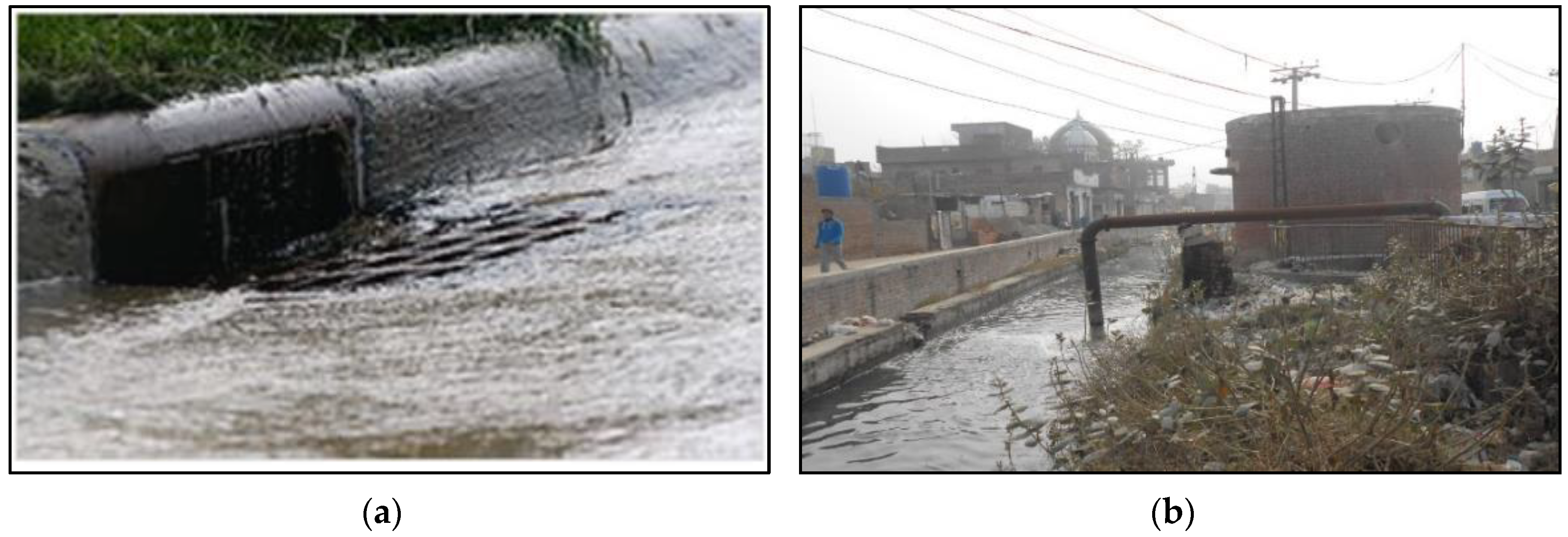
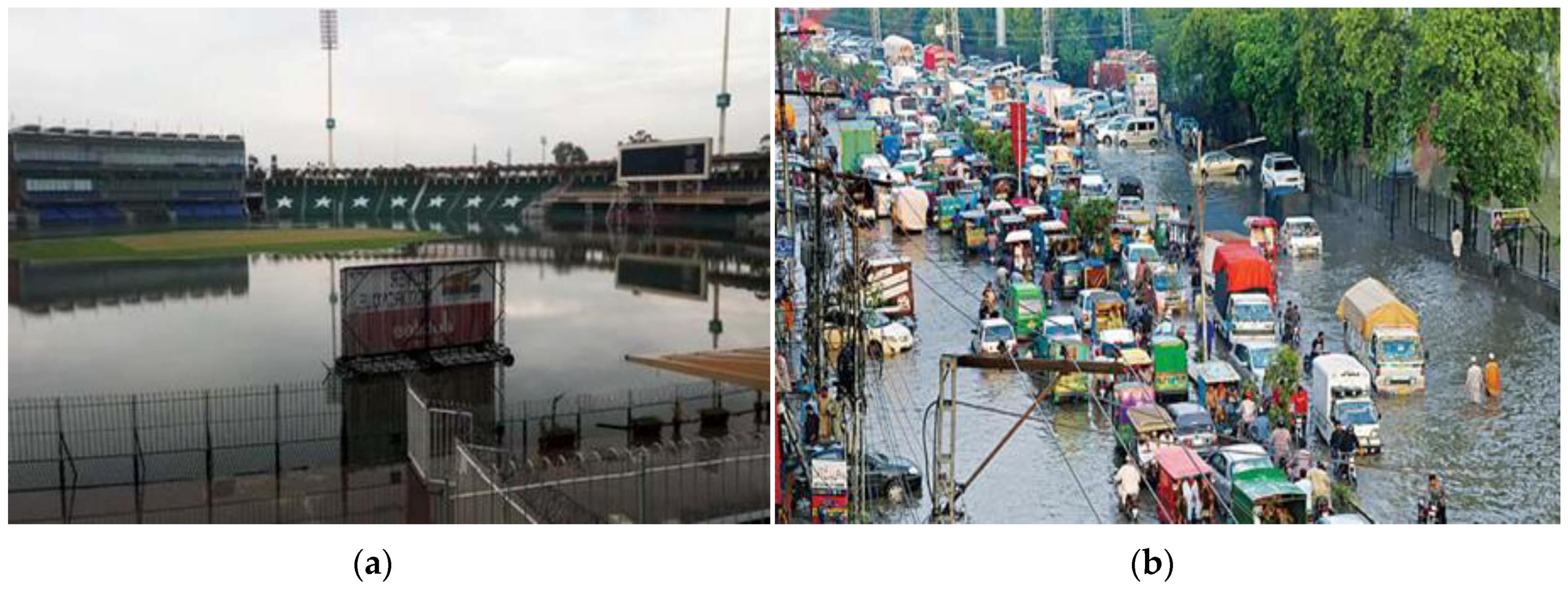
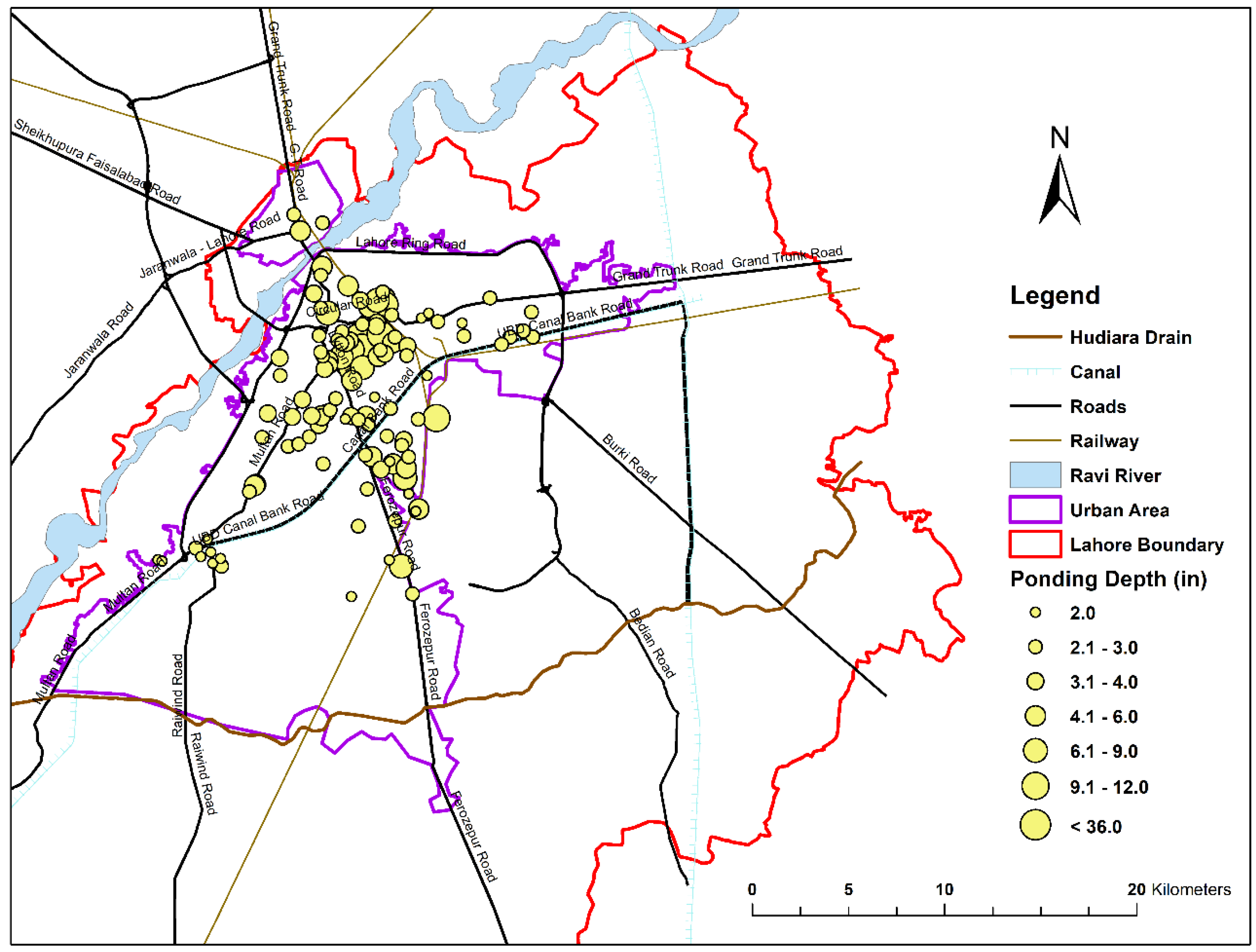
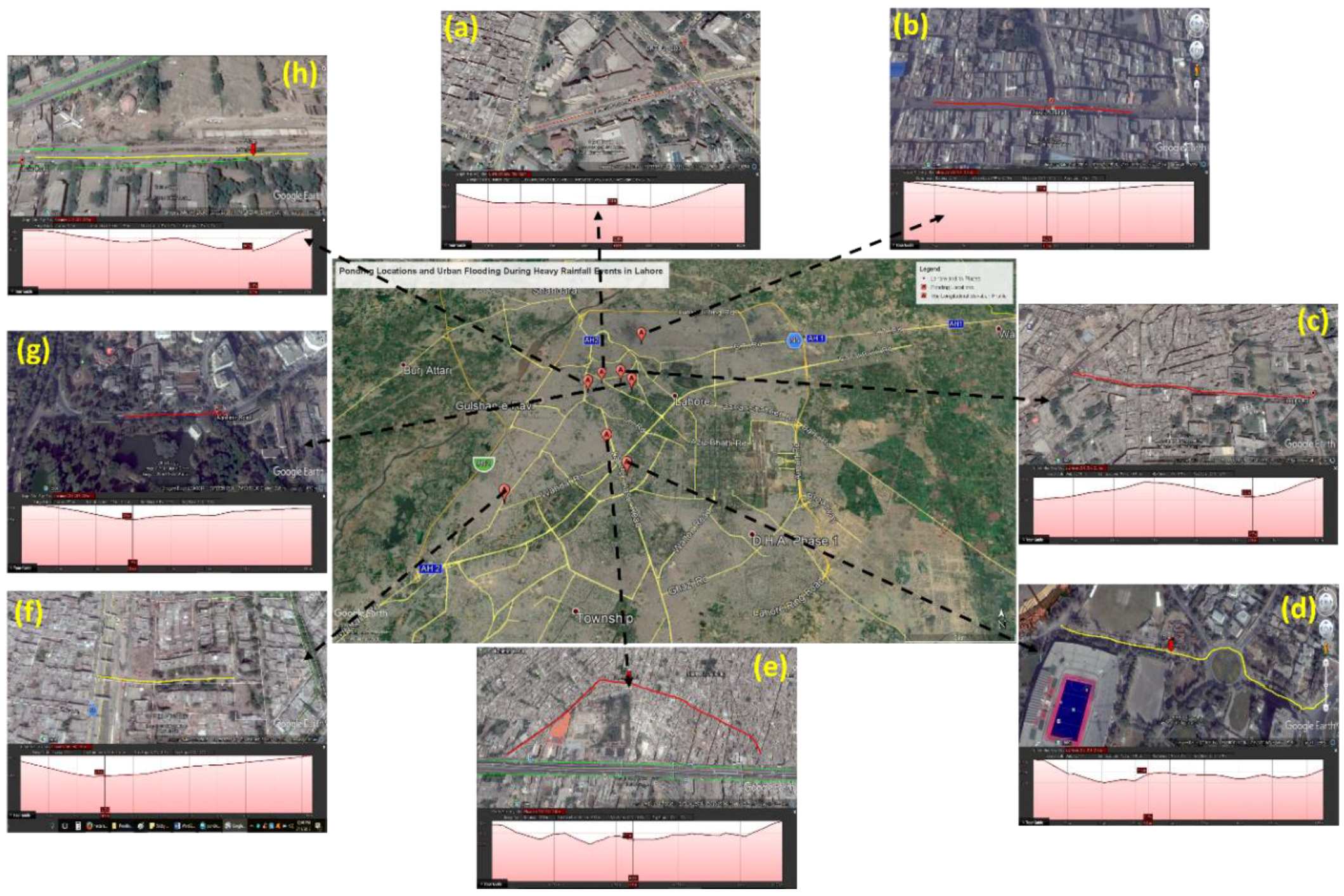
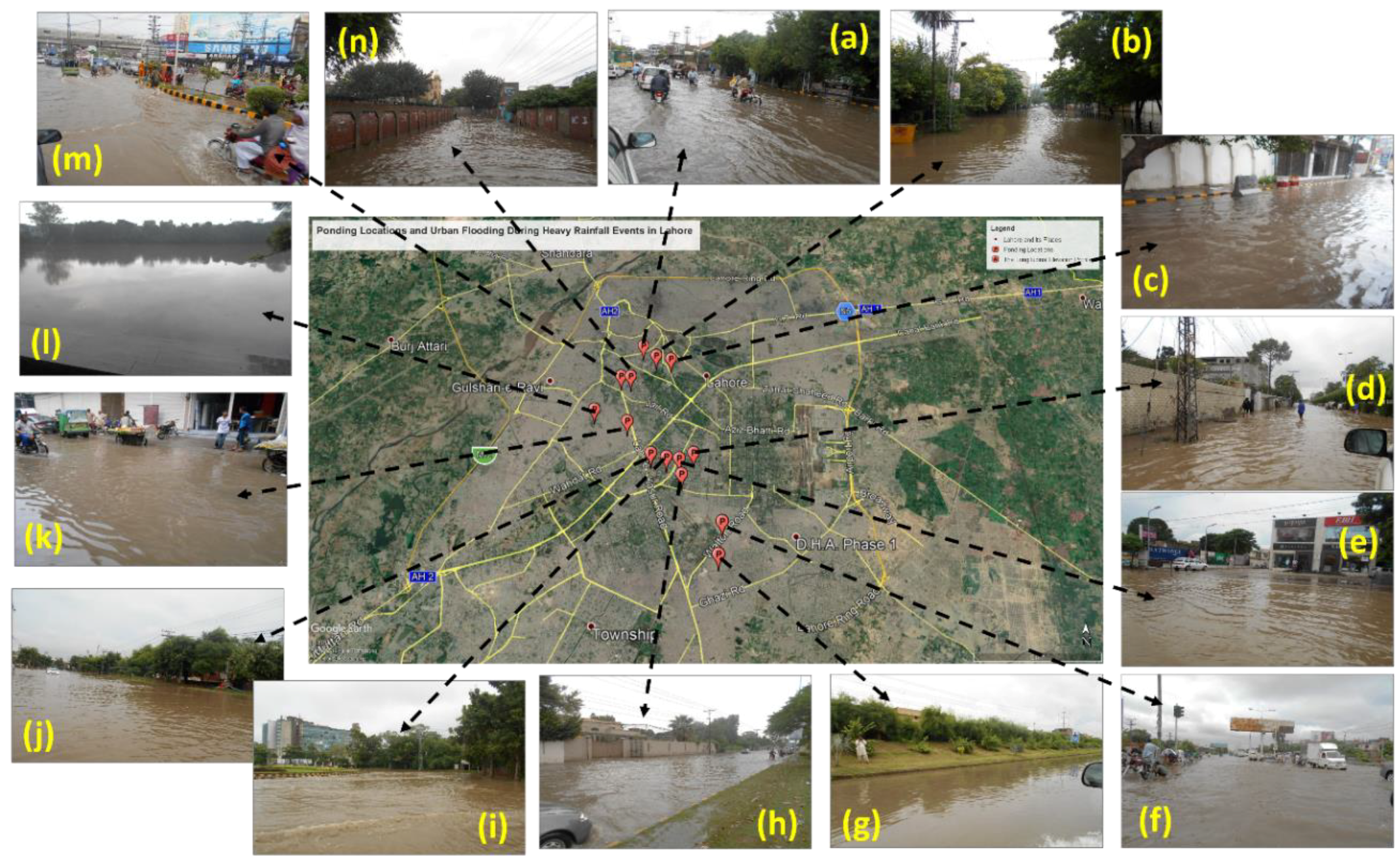
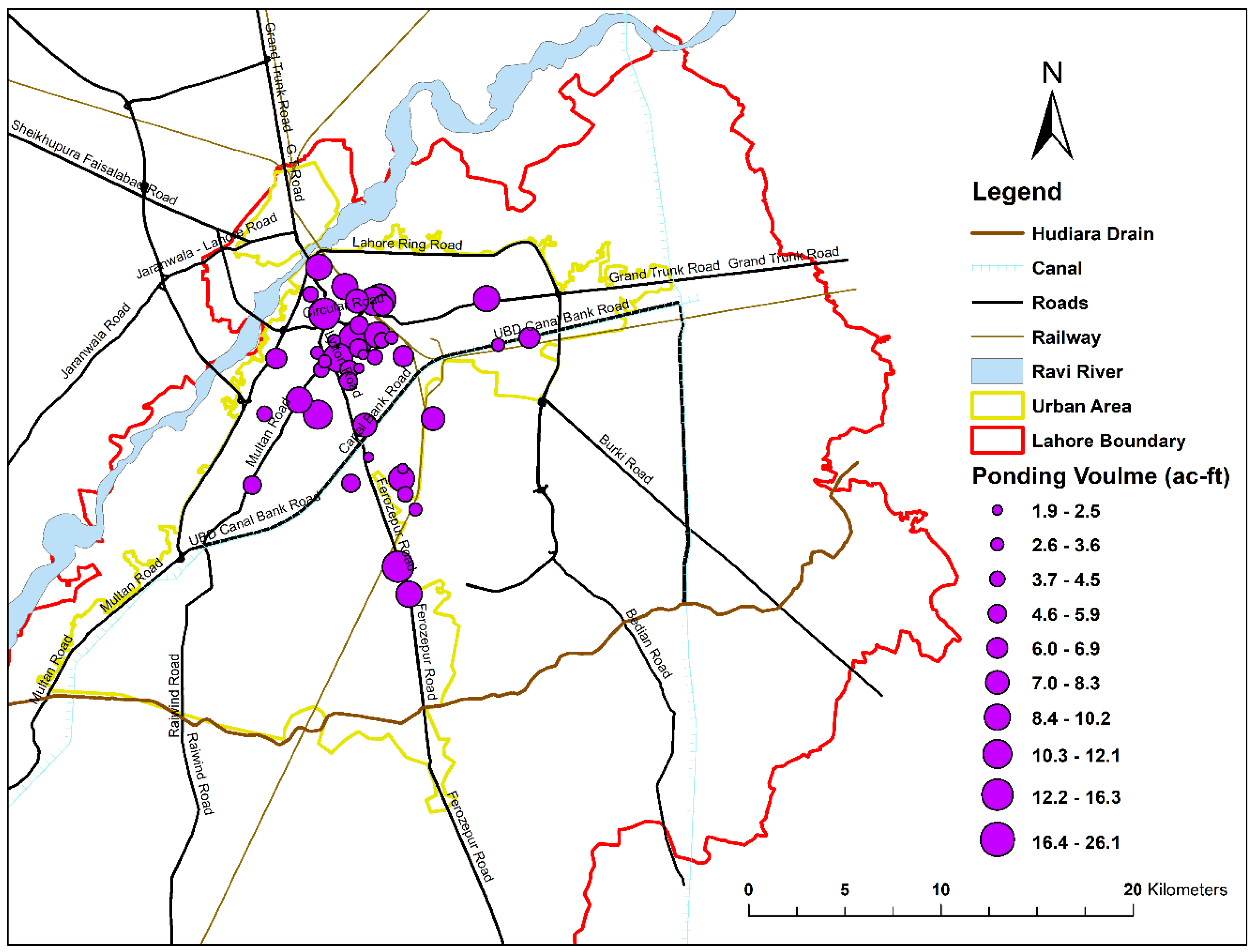
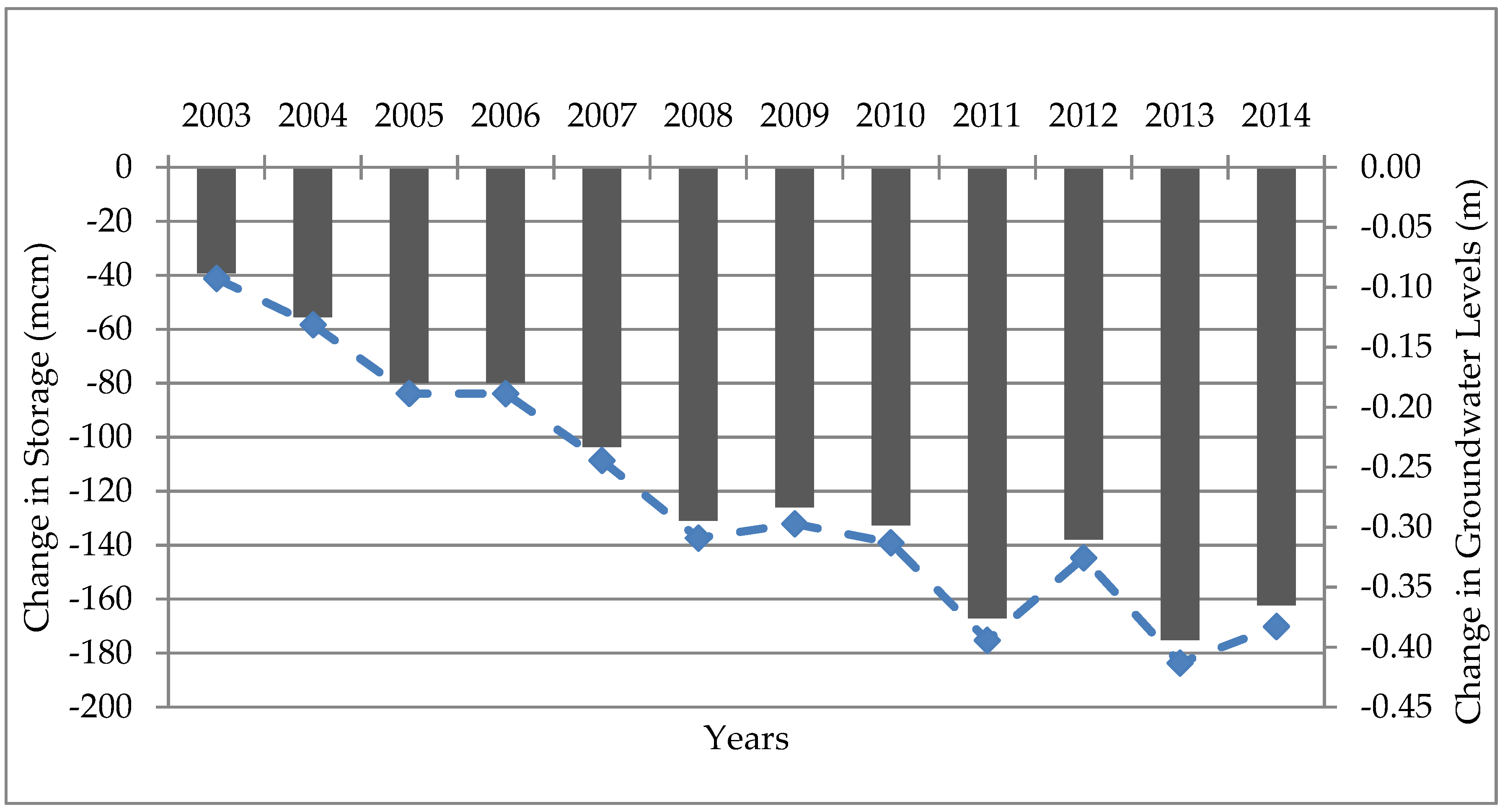
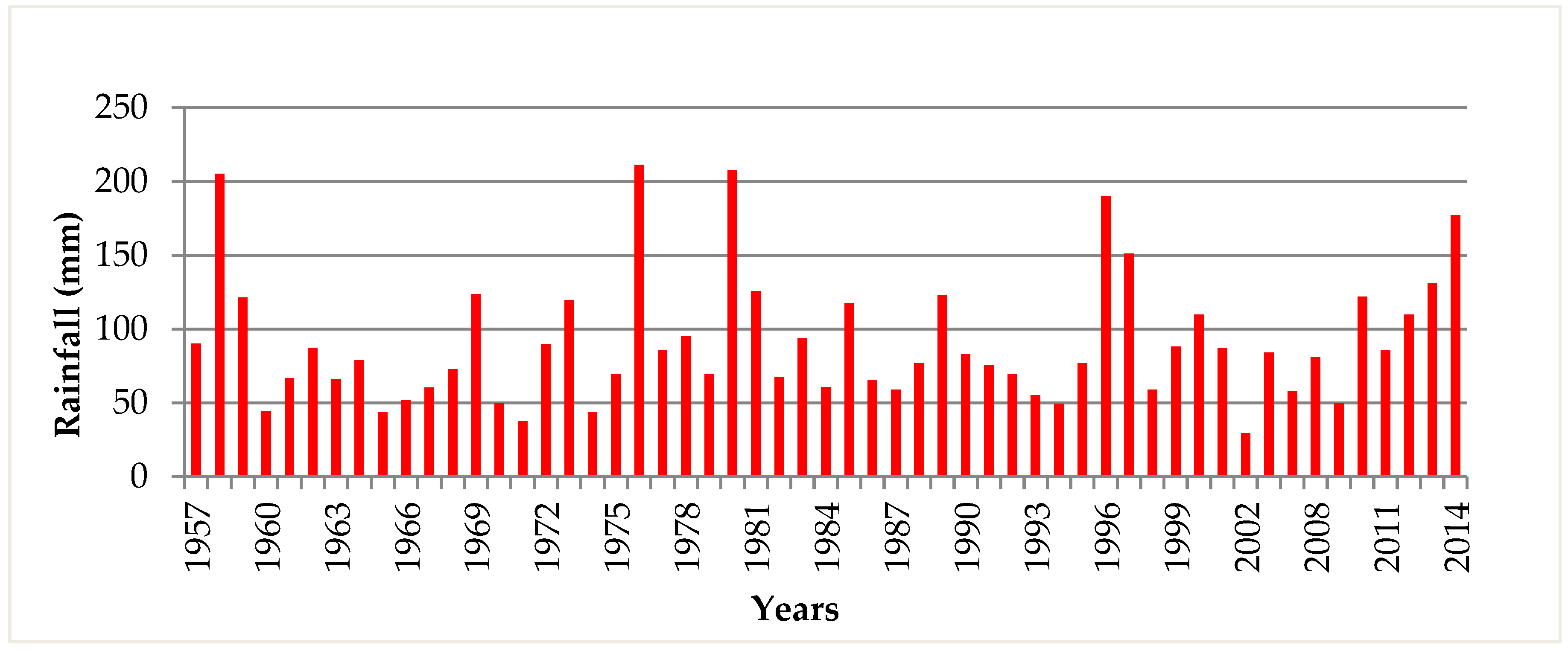
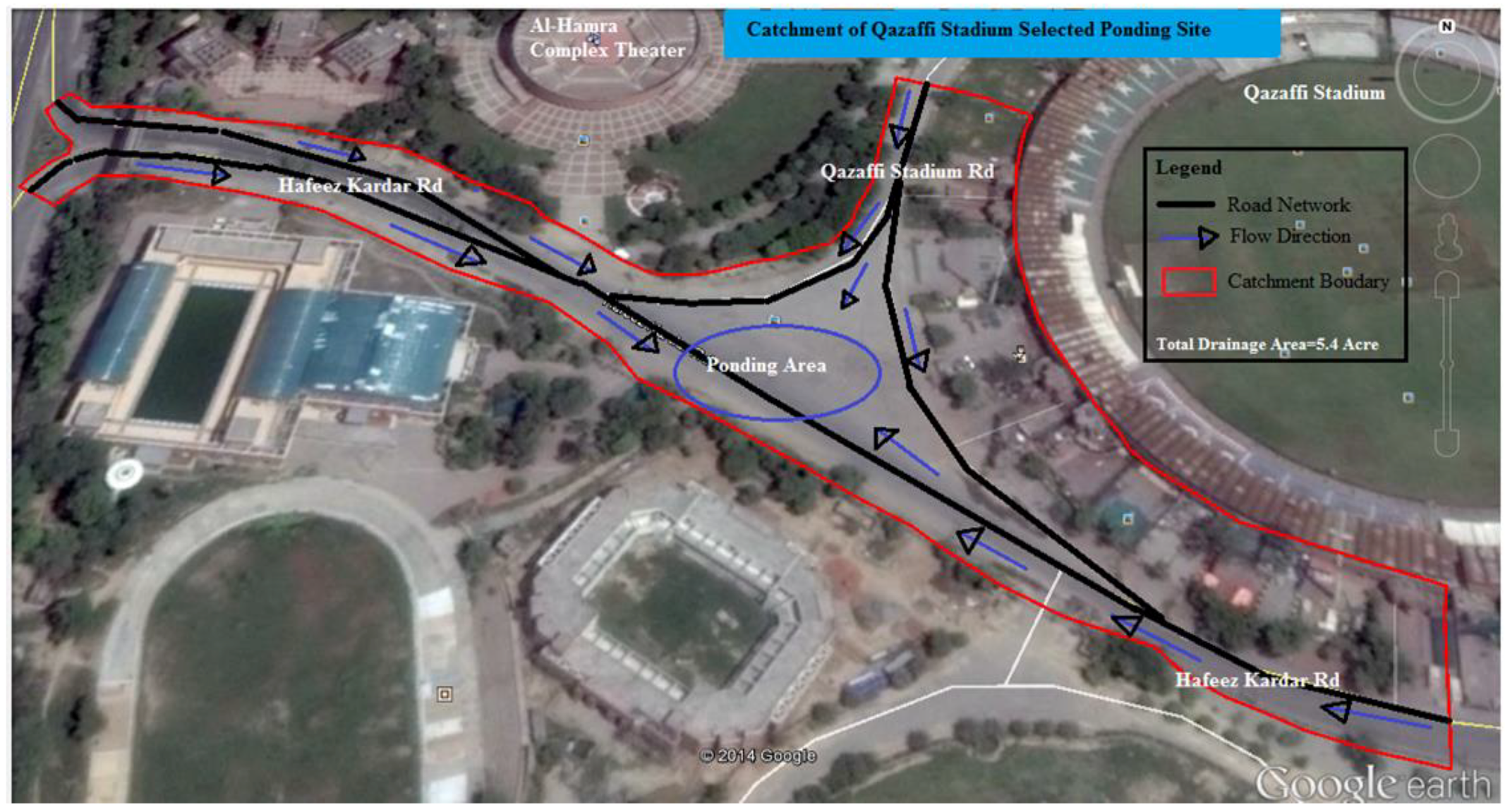
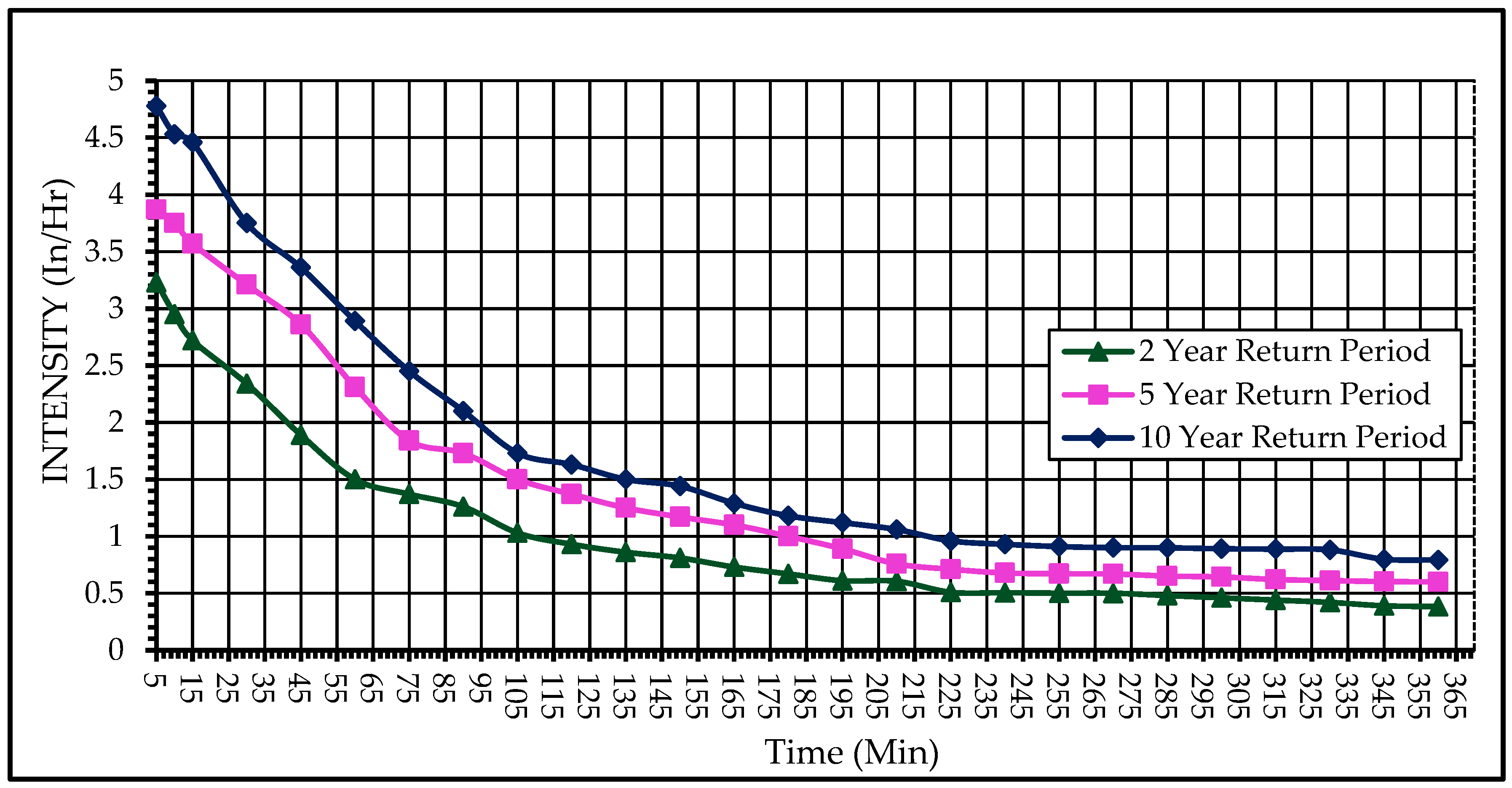
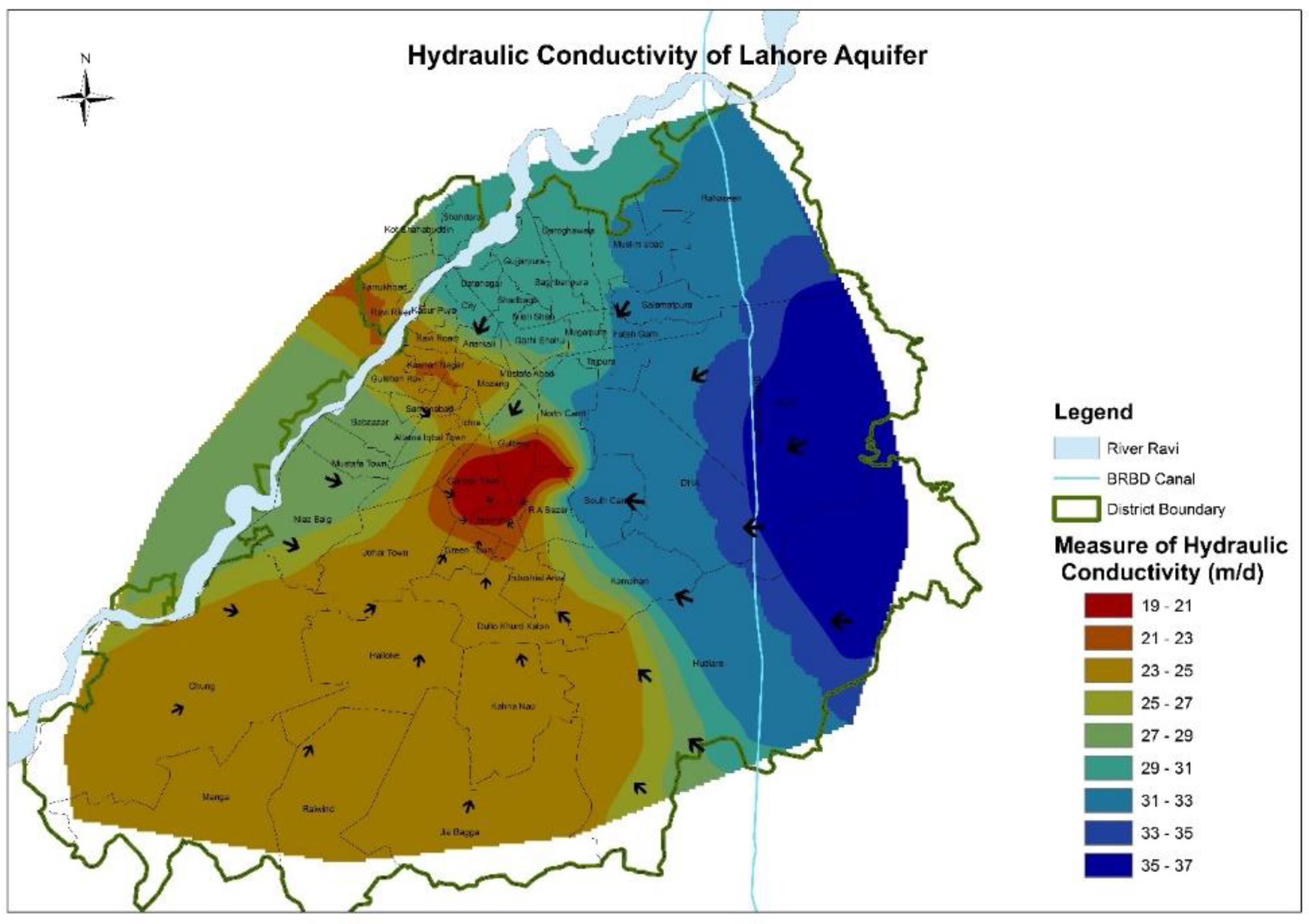
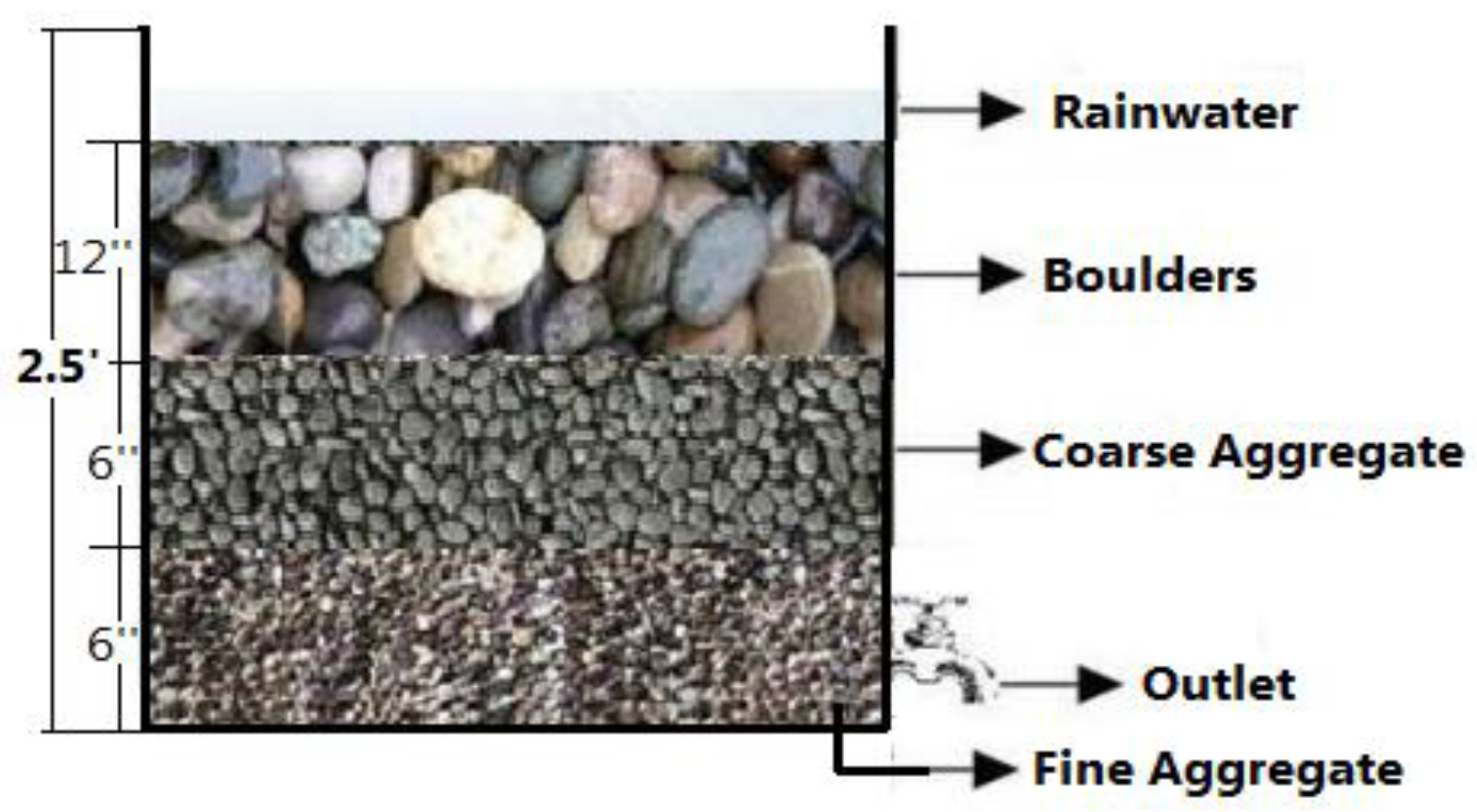
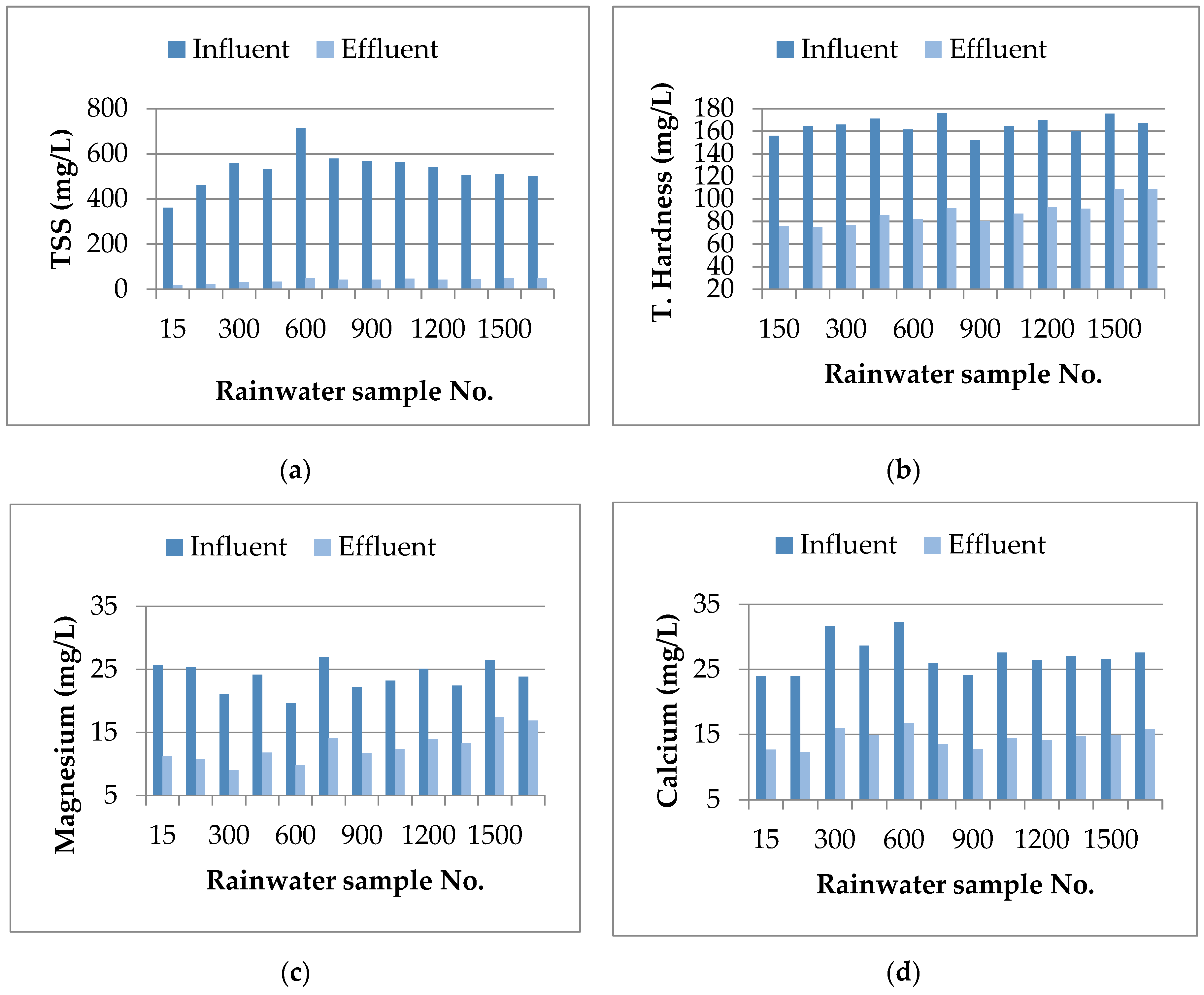
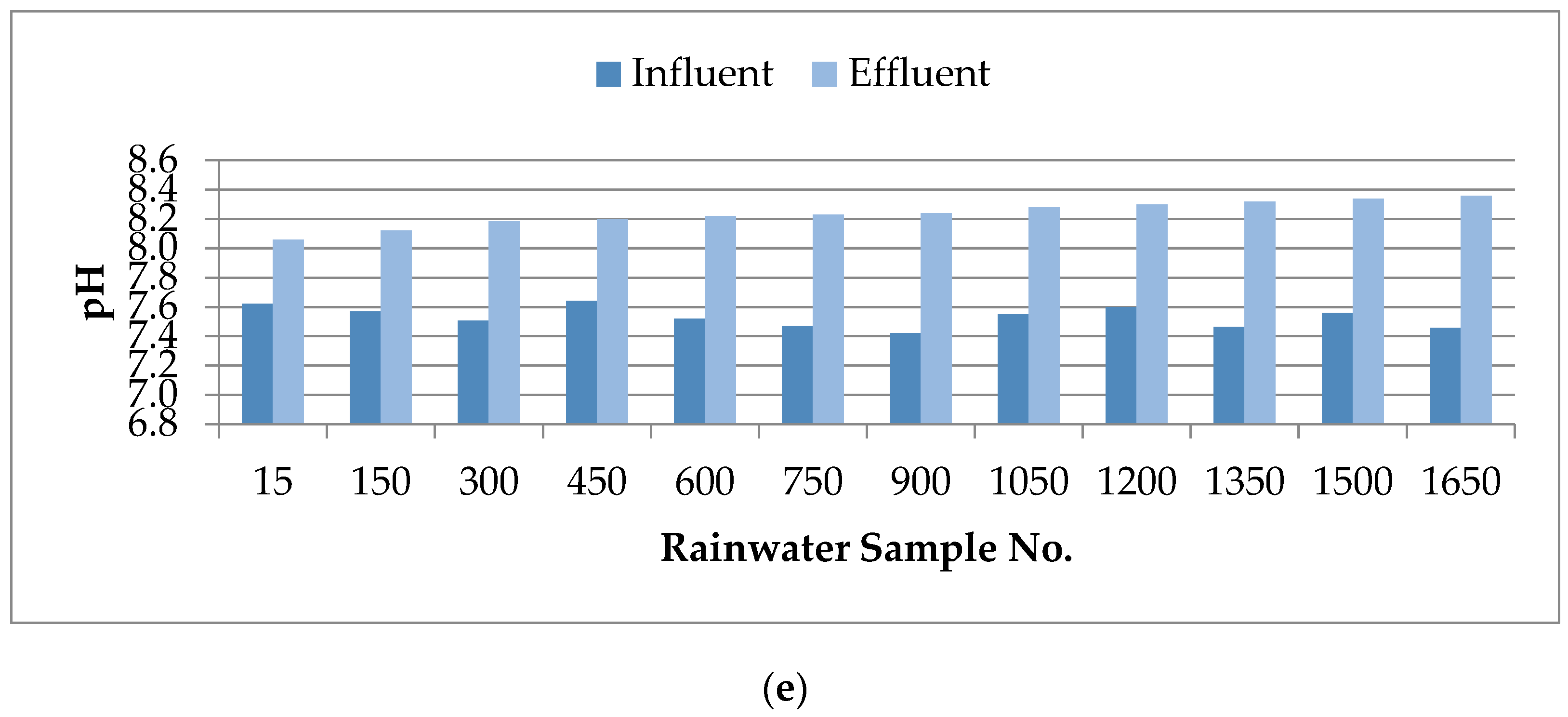
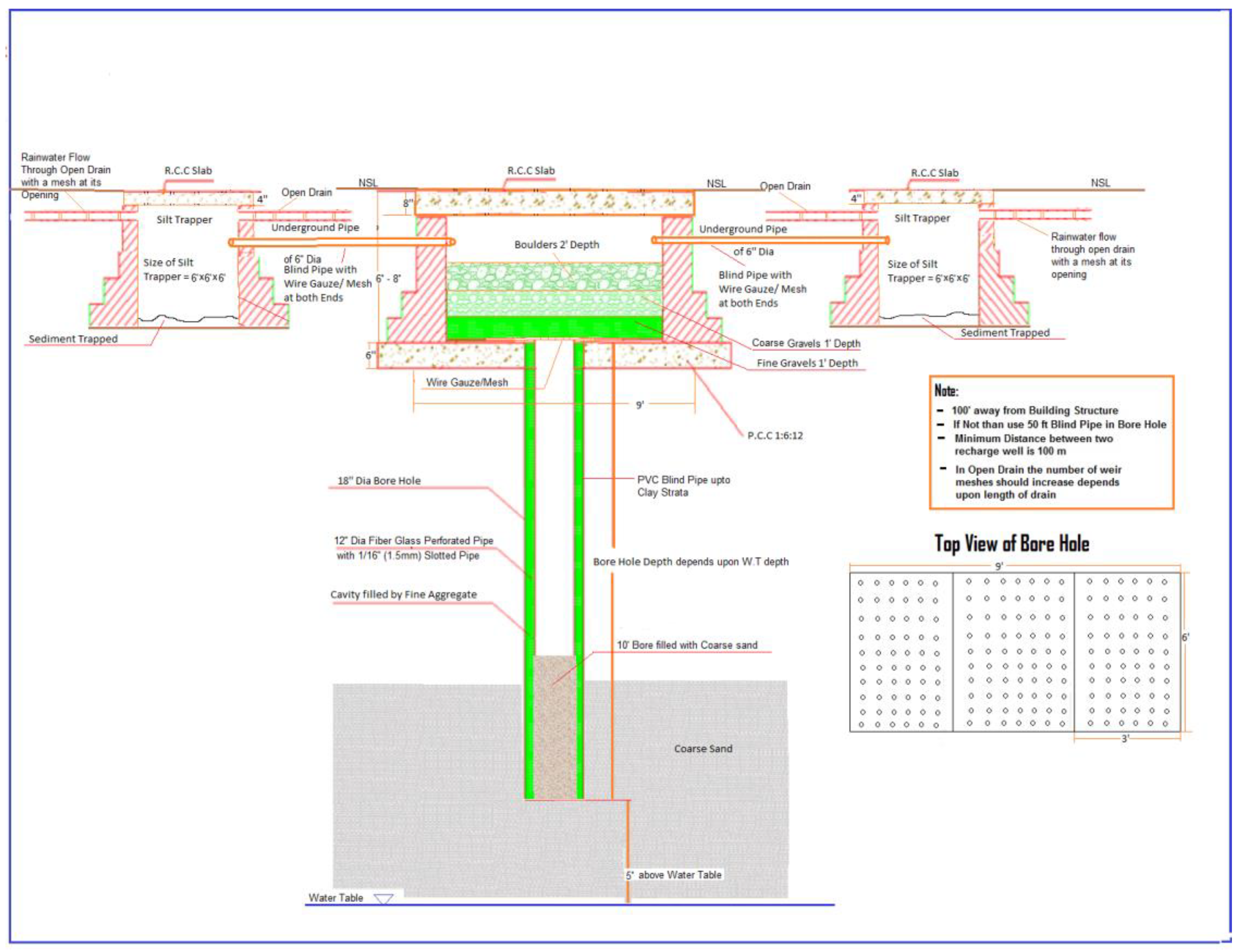
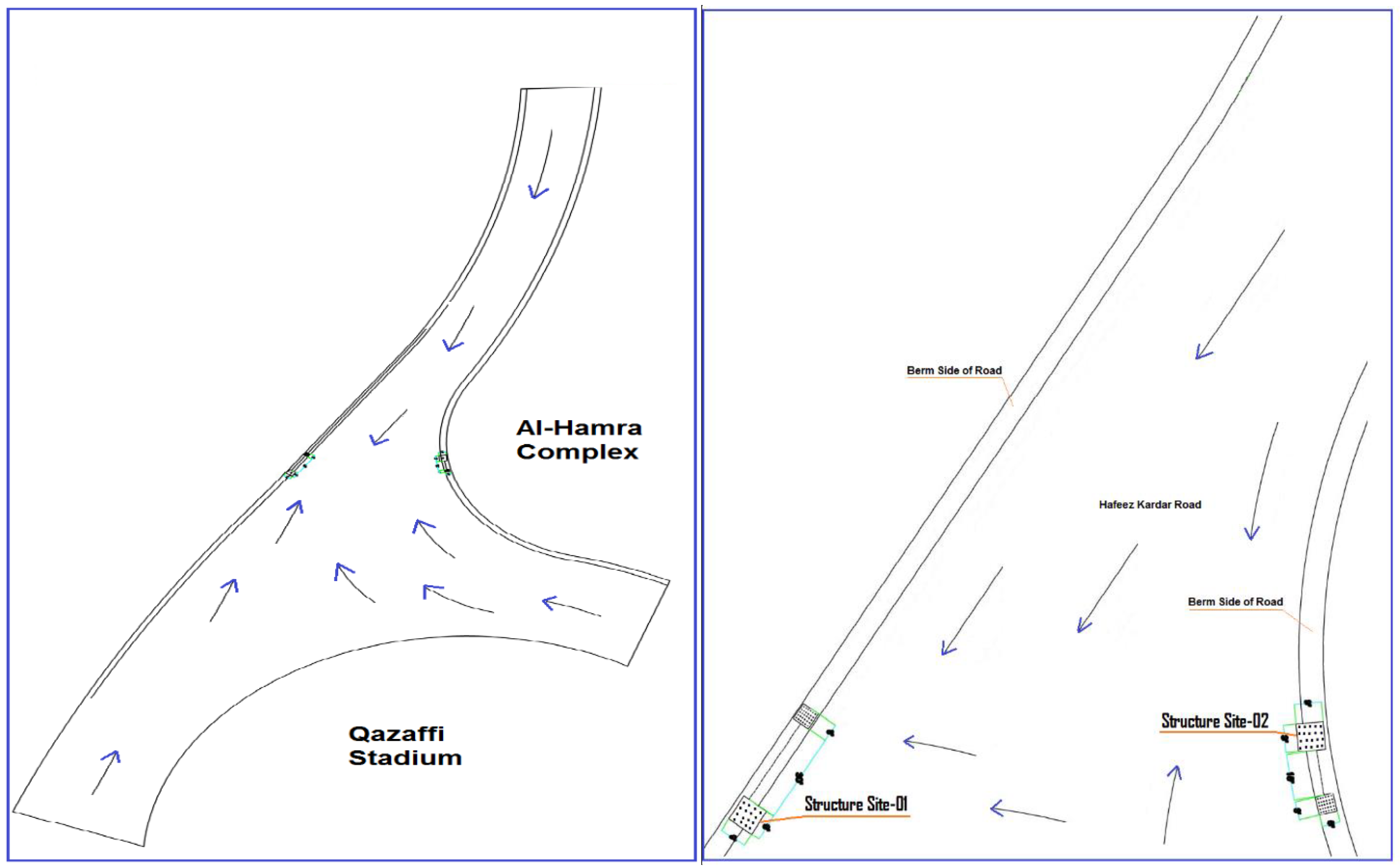
| Ponding Area Name | Ponding Depth (inch) | Inundation Area (ac) | Ponding Area Name | Ponding Depth (inch) | Inundation Area (ac) |
|---|---|---|---|---|---|
| Near Total Petrol Pump Bhala Chowk | 4 | 29.6 | Near Shrine of Shah Jamal | 3 | 29.5 |
| Doongi Ground Ghazali Rd | 7 | 20 | Fortress Stadium Circular Rd | 12 | 8.3 |
| Outside Bhati Gate Ravi Rd | 9 | 18.8 | Academy Rd, Railway officers colony | 6 | 6.7 |
| Laari Adda, GT Rd | 6 | 20.3 | Lawrence Road | 9 | 3 |
| Kachu Pura Near Kachu Pura Drain Misri Shah | 8 | 9.2 | Queen’s Road | 10 | 7.1 |
| Garhi Shahu Police Station, Allama Iqbal Rd | 3 | 25.1 | Lake Road Drain | 6 | 5.5 |
| Chowk Nakhuda Wasanpura Lahore | 9 | 21 | Mazang Adda | 8 | 18.2 |
| Bagh Pura Gullistan Rd | 3 | 25.6 | Abid Market | 8 | 24.5 |
| Shalamar Girls College Baghbanpura | 3 | 36.7 | Waris Rd | 6 | 11.6 |
| Gaddafi Stadium | 6 | 5.1 | Chauburji | 4 | 11.6 |
| Fruit Market | 6 | 10.8 | Hussain Chowk | 6 | 3.7 |
| Railway Drain Aziz Road | 8 | 16.3 | Firdous Market | 8 | 13.2 |
| Angoori Shadi Hall Link Shalamar Rd | 3 | 13.5 | Sheranwala Gate Circular Rd | 4 | 20.7 |
| Railway Colony | 3 | 4 | Vegetable & Fruit Market | 3 | 12 |
| Sunny View Complex Kashmir Rd | 6 | 8.8 | Timber Market Rd | 6 | 15.9 |
| Faletti’s Hotel Backside | 12 | 2.1 | Rasool Park Shama Rd New Muzang Lhr | 3 | 11.8 |
| Govt Islamia College Coper Rd | 10 | 6.8 | Near Bibi Pak Daman Allama Iqbal Rd | 6 | 17.8 |
| Dyal Singh College Lakshmi Chowk | 36 | 8.7 | GPO Backside | 3 | 8 |
| Islamia College Railway Rd | 3 | 22.1 | Karim Park | 4 | 13.4 |
| Haji Camp Empress Rd | 10 | 4.7 | Hall Road | 10 | 4.3 |
| Muslim League High School Empress Rd | 10 | 10.4 | Eik Moria Do Moria Pul | 9 | 13.5 |
| Barkat Market | 9 | 7.8 |
| Parameter | Unit | Sample-1 (Tubewell) | Sample-2 (Motorpump) | Limits as Per NEQS |
|---|---|---|---|---|
| Color | Pt-Co | <5.0 | <5.0 | ≤15 TCU |
| Odor | - | Odorless | Odorless | - |
| Turbidity | NTU | <0.2 | <0.2 | <5.0 NTU |
| Taste | - | Sweet | Sweet | - |
| pH | pH Unit | 7.98 | 8.37 | 6.5–8.5 |
| Hardness total as CaCO3 | mg/L | 136 | 56 | <500 |
| Total Dissolved Solids (TDS) | mg/L | 466 | 896 | <1000 |
| Chlorine (Residual) | mg/L | <1.0 | <1.0 | 0.5–1.5 |
| Nitrate (NO3) | mg/L | 0.49 | 0.62 | ≤50 |
| Nitrite (NO2) | mg/L | 0.007 | 0.005 | ≤3.0 |
| Chloride | mg/L | 15.65 | 39.14 | <250 |
| Cyanide CN | mg/L | <0.05 | <0.05 | ≤0.05 |
| Fluoride F- | mg/L | 0.43 | 0.41 | ≤1.50 |
| Arsenic (As) | mg/L | 0.01 | 0.02 | ≤0.05 |
| Barium (Ba) | mg/L | 0.04 | 0.02 | 0.70 |
| Boron (B) | mg/L | 0.11 | 0.29 | 0.30 |
| Selenium (Se) | mg/L | <0.005 | <0.005 | 0.01 |
| Zinc (Zn) | mg/L | <1.0 | <1.0 | 5 |
| Cadmium (Cd) | mg/L | <0.002 | <0.002 | 0.01 |
| Chromium (Cr) | mg/L | <0.02 | <0.02 | ≤0.05 |
| Copper (Cu) | mg/L | <1.0 | <1.0 | 2.0 |
| Antimony (Sb) | mg/L | <0.005 | <0.005 | ≤0.005 |
| Lead (Pb) | mg/L | <0.05 | <0.05 | ≤0.05 |
| Manganese (Mn) | mg/L | <0.5 | <0.5 | ≤0.5 |
| Nickel (Ni) | mg/L | <0.02 | <0.02 | ≤0.02 |
| Aluminum (Al) | mg/L | <0.005 | <0.005 | ≤0.2 |
| Mercury (Hg) | mg/L | <0.001 | <0.001 | ≤0.001 |
| Total Coliform | CFU/100 mL | Absent | Absent | 0/100 mL |
| Fecal Coliform (Escherichia coli) | CFU/100 mL | Absent | Absent | 0/100 mL |
| Sr. No | Water Quality Parameter | Permissible Limits | Results |
|---|---|---|---|
| 1 | Chloride (mg/L) | 250 (WHO) | 24 |
| 2 | Sulfate (mg/L) | 250 (WHO) | 07 |
| 3 | TDS (mg/L) | 1000 (WHO) | 78 |
| 4 | Biological Oxygen Demand (BOD) (mg/L) | 150 (NEQS) | 78 |
| 5 | Copper (mg/L) | 2 (WHO) | 0.13 |
| 6 | Arsenic (µg/L) | 10 (WHO) | 5.65 |
| 7 | Fluoride (mg/L) | 1.5 (WHO) | 0.20 |
| 8 | Total Coliform (MPN/100 mL) | 0 (WHO) | 96 |
| 9 | Fecal Coliform (E. Coli) (MPN/100 mL) | 0 (WHO) | 21 |
| 10 | Lead (ppm) | 0.05 mg/L (WHO) | Not detected |
| 11 | Cadmium (ppm) | 0.01 mg/L (WHO) | Not detected |
| 12 | Copper (ppm) | 2 mg/L (WHO) | Not detected |
| 13 | Pesticides residues as Chlorpyrifos (ppm) Bifenthrin (ppm) | Not detected | |
| 14 | Sulfides (ppm) | Not detected |
| Sr. No | Ponding Location | Catchment Areas (acres) | Runoff Volume (m3) | Recharging Capacity of Well (m3/h) | Ponding Area Clearance Time with a Drainage Factor 0.5 (h) | No. of Required Wells |
| 1 | Gaddafi Stadium | 5.43 | 616.2 | 29.32 | 10.5 | 2 |
| Sr. No | Work | Cost (PKR) |
|---|---|---|
| 1 | Excavation including dag-belling, dressing, refilling around structure with excavated earth, watering, ramming, re-handling, and transportation | 20,000.00 |
| 2 | Direct Rotary/Reverse Rotary drilling of in all types of soil except shingle, gravel, and rock | 50,000.00 |
| 3 | Cement concrete plain including placing, compacting, finishing, and curing. | 10,000.00 |
| 4 | Reinforced Cement Concrete (RCC) (1:2:4), main slabs | 20,000.00 |
| 5 | Fabrication of mild steel, deformed bars grade-40 | 30,000.00 |
| 6 | Cement plaster 1:3 | 5000.00 |
| 7 | Suppling and filling sand | 5000.00 |
| 8 | Brick masonry (1:3) other than building | 30,000.00 |
| 9 | Installing fiber glass blank pipe in the borehole including joining with the fiber glass blank pipe/strainer | 165,000.00 |
| 10 | Installing fiber glass strainer pipe in the borehole including joining | 185,000.00 |
| 11 | Providing and laying crush stone (3/4’’ to 1’’) | 8000.00 |
| 12 | Providing and laying coarse gravels and boulders | 5000.00 |
| 13 | Fixing wire mesh | 2000.00 |
| 14 | Miscellaneous items | 5000.00 |
| Sub-total | 540,000.00 | |
| 2% Contingencies | 108,000.00 | |
| Repair and maintenance cost | 90,000.00 | |
| Grand total | 738,000.00 | |
| Grand total (M.PKR) | 0.738 | |
| Grand total (USD) At 1 USD = 100 PKR | 7380.00 | |
| Sr. No | Water Quality Parameter | Permissible Limits | Pre-Harvesting | Post-Harvesting |
|---|---|---|---|---|
| 1 | Chloride (mg/L) | 250 (WHO) | 24 | 5.6 |
| 2 | Sulfate (mg/L) | 250 (WHO) | 07 | 03 |
| 3 | TDS (mg/L) | 600 (WHO) | 78 | 19 |
| 4 | BOD (mg/L) | 80 (NEQS) | 78 | *BDL |
| 5 | Copper (mg/L) | 2 (WHO) | 0.13 | 0.7 |
| 6 | Arsenic (µg/L) | 10 (WHO) | 5.65 | 2.65 |
| 7 | Fluoride (mg/L) | 1.5 (WHO) | 0.20 | 0.10 |
| 8 | Total Coliform (MPN/100 mL) | 0 (WHO) | 96 | 10 |
| 9 | Fecal Coliform (E. Coli) (MPN/100 mL) | 0 (WHO) | 21 | 3 |
| 10 | Lead (ppm) | 0.05 mg/L (WHO) | Not detected | Not detected |
| 11 | Cadmium (ppm) | 0.01 mg/L (WHO) | Not detected | Not detected |
| 12 | Copper (ppm) | 2 mg/L (WHO) | Not detected | Not detected |
| 13 | Pesticides residues as Chlorpyrifos (ppm) Bifenthrin (ppm) | Not detected | Not detected | |
| 14 | Sulfides (ppm) | Not detected | Not detected |
© 2019 by the authors. Licensee MDPI, Basel, Switzerland. This article is an open access article distributed under the terms and conditions of the Creative Commons Attribution (CC BY) license (http://creativecommons.org/licenses/by/4.0/).
Share and Cite
Hussain, F.; Hussain, R.; Wu, R.-S.; Abbas, T. Rainwater Harvesting Potential and Utilization for Artificial Recharge of Groundwater Using Recharge Wells. Processes 2019, 7, 623. https://doi.org/10.3390/pr7090623
Hussain F, Hussain R, Wu R-S, Abbas T. Rainwater Harvesting Potential and Utilization for Artificial Recharge of Groundwater Using Recharge Wells. Processes. 2019; 7(9):623. https://doi.org/10.3390/pr7090623
Chicago/Turabian StyleHussain, Fiaz, Riaz Hussain, Ray-Shyan Wu, and Tanveer Abbas. 2019. "Rainwater Harvesting Potential and Utilization for Artificial Recharge of Groundwater Using Recharge Wells" Processes 7, no. 9: 623. https://doi.org/10.3390/pr7090623
APA StyleHussain, F., Hussain, R., Wu, R.-S., & Abbas, T. (2019). Rainwater Harvesting Potential and Utilization for Artificial Recharge of Groundwater Using Recharge Wells. Processes, 7(9), 623. https://doi.org/10.3390/pr7090623






